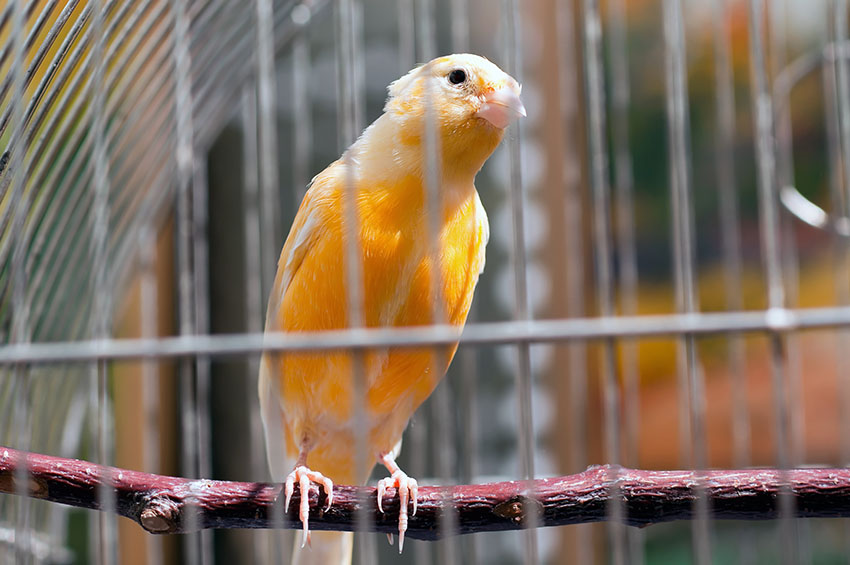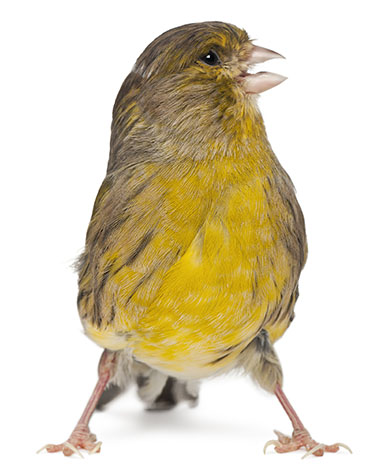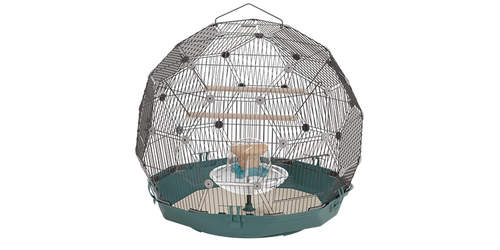All species of pet finch require the same kind of cage. The emphasis needs to be on the horizontal rather than the vertical - finches fly and hop across the space they are given. A tall but narrow cage might suit a climbing bird - a cockatiel or other small parrot, for example - but finches do not climb, so a parrot cage is not usually suitable. Also, a cage designed for a different type of bird will often have too much space between the bars. A finch’s bars need to be less than 1.5cm apart, otherwise the birds are in danger of poking their heads out and getting them stuck, or even escaping.
The cage needs to be safe, so make sure there are no sharp edges, or toe-snagging hazards. This applies to the exterior and door area of the cage too, as you may decide to give your Canary some free-flying time, in which case he will perch in the doorway and on top of the cage. Any perch, toy or fastener you introduce should be safe too, with no sharp edges, and nothing into which heads or feet could get jammed.

A cage needs plenty of space for flight
Finch Cage Shape
If you can only provide a small space for your birds, it’s best to go for a cage with corners, as finches take comfort in corners when close confined. If your cage is larger - at least 90 cm across - the shape becomes less of an issue; although a completely round cage without angles (such as the classic Victorian style bird cage - the kind of thing Tweety Pie is confined to in the cartoons) is best avoided. Again, you’re looking for width, not height.
Cage Size
The minimum dimensions for a cage containing three pairs of Zebra finch-sized birds are 150x50x50cm. The general rule is to provide as much space as possible. For a single Canary, the minimum requirements are a cage 40cm wide and 20cm deep with a perch at each end. Anything smaller and the bird will not get sufficient exercise. This begs a fundamental question: do you have enough room, and a suitable spot, for a bird cage?
It’s best to save up and buy the best cage you can, before buying the birds, rather than opting for something cheap-and-not-very-cheerful, or placing your pets in temporary lodgings.
Canaries are the only pet finches that can be kept alone. Zebra finches, and all the other pet finches mentioned in this guide, need to live in cock-hen pairs, often within larger groups. Most species are territorial, and will tend to fight their way up the group hierarchy. If you are keeping more than a pair, you will need a lot of space, to enable the birds lower down the social scale to find a safe corner when the dominant birds are flexing their muscles.
How Many Finches in a Cage?
The number of birds you can keep depends on the space you have available. A single Canary will be happy in a cage of 40x20x20cm, and a pair of Zebra finches thrive in this confined space too, although you should provide as much space for them as you can manage. Small is not best, it is merely adequate. In larger set ups you can keep more birds. The rule of thumb is to provide 90cm2 per bird.
How Many Canaries in a Cage?
Canaries don’t rely on the company of other birds for happiness. They’re not complete loners, as they forage in small groups or larger, temporary flocks; and in captivity they get along very well most of the time. But once the mating urge comes upon them (and it lasts for up to five months each year), the cock birds become territorial and aggressive. Hens, too, can become over-territorial at this time. In the wild they can simply keep out of each other’s way, but in a cage there can be confrontations.

Canaries thrive on their own
The answer, if you keep more than one bird, is to have separate cages for separate individuals or pairs, or to keep them in a sufficiently large space, with foliage, to allow the timid ones to keep out the way. If not, the less dominant birds will be stressed, or bullied, both of which can lead to death.





Comments
There are no comments just yet